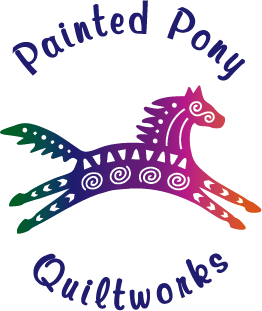Tips for a beautiful machine quilting job: or How to ensure that your Longarm Quilter is always happy to see you.
Adding Borders: To prevent wavy borders, I recommend following this practice: Measure the width and length of the top in 2-3 places – down the middle and several inches from each edge. Take the average of these measurements and cut your border pieces. Pin the border to the top in the middle and on the ends then ease in the border, or stretch if necessary, and continue to pin. It is difficult to hide a wavy border with an edge-to-edge pantograph.
Buttons, Beads, Rick-rack: Whenever possible please add these to your quilt after it has been quilted. It is very difficult to quilt around buttons, beads, crystals, etc. The hopping foot may not be able to get around certain things leaving larger areas unquilted. Piping and flanges present similar challenges and will add to your quilting charges.
Consider who the quilt is going to be given to, as well as the intended use. If the quilt is for a man, we probably don’t want to use a flowery quilting design. If it is going to be cuddled or tossed around a college dorm room, we probably don’t want it highly quilted. On the other hand, if you make a Double Irish Chain or another design with lots of variation between the color/contrast and you wish to show it in a quilt show, (and your budget can afford it), we should talk about custom quilting.
Press your quilt top. The quilting will look much better if the seams are all pressed down and in the right direction. Flat intersections ensure smooth quilting lines.
Trim any threads. Dark threads can show through under a lighter fabric.
Quilting thread. Please let me supply the thread for your quilt. First, I can get it less expensively than you can. Second and even more important, you don’t know how old that cone of thread sitting at your LQS is. Cotton threads will dry out and can dry out quickly if stored in the wrong environment. This translates to all kinds of problems for the longarm quilting machine, taking up valuable, billable time, and will affect the outcome of your quilt, not to mention the cussing I’m going to be doing!
Make sure the backing is the proper size. The backing fabric should be at least 4” larger than the quilt top on all sides after squaring. If the batting you choose is extra thick or you want dense quilting, please allow at least 4” on each side.
Square up the backing. Please ask me if you need help with this.
Backing Fabric: Believe it or not, this is an important decision! If you want the quilting to show, or choose a more intricate pantograph, you should opt for a more solid or not-too-busy backing fabric. I try to use the same color thread in the top and the backing, so try to have your backing blend with the top. Stitches will blend into a busy backing fabric more than a plain backing fabric.
Please remove selvages from the seams, for best results, seam the backing with a one-half inch seam, and trim the selvage off. Press the seam open. Selvages on the outside edge are never a problem. It gives me a straight side to work with!
The batting needs to be at least 3” larger than the quilt top on all sides.
I offer Batting:
Hobbs Heirloom 80/20. I sell the batting just like fabric. My batting rolls are approximately 96-98 inches wide. $17.00/yd
Hobbs Polydown. 100% polyester. A poufy batting that shows texture in quilting. 108 inches wide. $15.00/yd
Quilter’s Dream Batting. Queen size packages. Cotton, Poly and wool! Individually priced.
I am looking forward to quilting your treasured quilt tops!!
